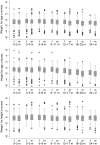Factors associated with increased risk of progression to respiratory syncytial virus-associated pneumonia in young Kenyan children
- PMID: 18482199
- PMCID: PMC2635480
- DOI: 10.1111/j.1365-3156.2008.02092.x
Factors associated with increased risk of progression to respiratory syncytial virus-associated pneumonia in young Kenyan children
Abstract
Objectives: To identify factors associated with developing severe respiratory syncytial virus (RSV) pneumonia and their commonality with all-cause lower respiratory tract infection (LRTI), in order to isolate those risk factors specifically associated with RSV-LRTI and identify targets for control.
Methods: A birth cohort of rural Kenyan children was intensively monitored for acute respiratory infection (ARI) over three RSV epidemics. RSV was diagnosed by immunofluorescence of nasal washings collected at each ARI episode. Cox regression was used to determine the relative risk of disease for a range of co-factors.
Results: A total of 469 children provided 937 years of follow-up, and experienced 857 all-cause LRTI, 362 RSV-ARI and 92 RSV-LRTI episodes. Factors associated with RSV-LRTI, but not RSV-ARI, were severe stunting (z-score < or =-2, RR 1.7 95%CI 1.1-2.8), crowding (increased number of children, RR 2.6, 1.0-6.5) and number of siblings under 6 years (RR 2.0, 1.2-3.4). Moderate and severe stunting (z-score < or =-1), crowding and a sibling aged over 5 years sleeping in the same room as the index child were associated with increased risk of all-cause LRTI, whereas higher educational level of the primary caretaker was associated with protection.
Conclusion: We identify factors related to host nutritional status (stunting) and contact intensity (crowding, siblings) which are distinguishable in their association with RSV severe disease in infant and young child. These factors are broadly in common with those associated with all-cause LRTI. The results support targeted strategies for prevention.
Figures


Similar articles
-
Risk factors for respiratory syncytial virus associated with acute lower respiratory infection in children under five years: Systematic review and meta-analysis.J Glob Health. 2015 Dec;5(2):020416. doi: 10.7189/jogh.05.020416. J Glob Health. 2015. PMID: 26682048 Free PMC article. Review.
-
Respiratory syncytial virus infection and disease in infants and young children observed from birth in Kilifi District, Kenya.Clin Infect Dis. 2008 Jan 1;46(1):50-7. doi: 10.1086/524019. Clin Infect Dis. 2008. PMID: 18171213 Free PMC article.
-
Respiratory syncytial virus epidemiology in a birth cohort from Kilifi district, Kenya: infection during the first year of life.J Infect Dis. 2004 Nov 15;190(10):1828-32. doi: 10.1086/425040. Epub 2004 Oct 8. J Infect Dis. 2004. PMID: 15499540
-
Incidence and Risk Factors for Respiratory Syncytial Virus and Human Metapneumovirus Infections among Children in the Remote Highlands of Peru.PLoS One. 2015 Jun 24;10(6):e0130233. doi: 10.1371/journal.pone.0130233. eCollection 2015. PLoS One. 2015. PMID: 26107630 Free PMC article.
-
Nosocomial respiratory syncytial virus infections in children's wards.Diagn Microbiol Infect Dis. 2000 Aug;37(4):237-46. doi: 10.1016/s0732-8893(00)00154-1. Diagn Microbiol Infect Dis. 2000. PMID: 10974574 Review.
Cited by
-
Household crowding, social mixing patterns and respiratory symptoms in seven countries of the African meningitis belt.PLoS One. 2014 Jul 2;9(7):e101129. doi: 10.1371/journal.pone.0101129. eCollection 2014. PLoS One. 2014. PMID: 24988195 Free PMC article. Clinical Trial.
-
Risk factors for respiratory syncytial virus associated with acute lower respiratory infection in children under five years: Systematic review and meta-analysis.J Glob Health. 2015 Dec;5(2):020416. doi: 10.7189/jogh.05.020416. J Glob Health. 2015. PMID: 26682048 Free PMC article. Review.
-
Impact of Childhood Malnutrition on Host Defense and Infection.Clin Microbiol Rev. 2017 Oct;30(4):919-971. doi: 10.1128/CMR.00119-16. Clin Microbiol Rev. 2017. PMID: 28768707 Free PMC article. Review.
-
Tackling malnutrition: a systematic review of 15-year research evidence from INDEPTH health and demographic surveillance systems.Glob Health Action. 2015 Oct 29;8:28298. doi: 10.3402/gha.v8.28298. eCollection 2015. Glob Health Action. 2015. PMID: 26519130 Free PMC article. Review.
-
Household air quality risk factors associated with childhood pneumonia in urban Dhaka, Bangladesh.Am J Trop Med Hyg. 2014 May;90(5):968-75. doi: 10.4269/ajtmh.13-0532. Epub 2014 Mar 24. Am J Trop Med Hyg. 2014. PMID: 24664785 Free PMC article.
References
-
- Aaby P. Malnutrition and overcrowding/intensive exposure in severe measles infection: review of community studies. Reviews of Infectious Diseases. 1988;10:478–491. - PubMed
-
- Aaby P, Coovadia H. Severe measles: a reappraisal of the role of nutrition, overcrowding and virus dose. Medical Hypotheses. 1985;18:93–112. - PubMed
-
- Aaby P, Bukh J, Lisse IM, Smits AJ. Measles mortality, state of nutrition, and family structure: a community study from Guinea-Bissau. Journal of Infectious Diseases. 1983;147:693–701. - PubMed
-
- Aaby P, Bukh J, Lisse IM, Smits AJ. Overcrowding and intensive exposure as determinants of measles mortality. American Journal of Epidemiology. 1984;120:49–63. - PubMed
-
- Adegbola RA, Falade AA, Sam BE, et al. The etiology of pneumonia in malnourished and well-nourished Gambian children. The Pediatric Infectious Disease Journal. 1994;13:975–982. - PubMed
Publication types
MeSH terms
Grants and funding
LinkOut - more resources
Full Text Sources
Medical

